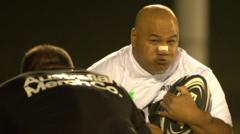The Run It Championship League, a new collision sport originating from Australia, has gained immense popularity and sponsorship support. However, rising concerns from medical experts and community voices highlight the potential dangers of the game, emphasizing its possible implications on mental health and well-being.
"Run It Championship: The New Frontier of Collision Sports Faces Safety Backlash"

"Run It Championship: The New Frontier of Collision Sports Faces Safety Backlash"
As a thrilling new collision sport gains traction globally, concerns arise over player safety and its impact on participants' well-being.
In Australia and New Zealand, a new collision sport called Run It is rapidly gaining popularity and igniting debate over safety protocols. The sport is a high-octane version of one-on-one tackling games traditionally played in backyards and schoolyards, originating particularly from Pacific Islander communities. Participants charge at each other full speed without protective gear, aiming to dominate the other in a display that resembles a gladiatorial clash.
The Run It Championship League has utilized this viral success to establish organized competitions, which have taken place in cities such as Melbourne and Auckland. A prominent upcoming event in Dubai promises a massive prize pool of A$200,000 (£98,000) for the winners. The league’s dramatic social media presence, combined with partnerships with notable sponsors, indicates a promising future. Yet, as interest surges, so do criticisms from medical professionals and concerned advocates regarding the potential health consequences of the sport.
Medical experts argue that the nature of the game poses serious risks to the players, with one notable incident involving a young participant losing his life after emulating moves seen online. This sparked a wave of worry among families and advocates within the Pacific Islander community about the sport's glorification of violence and how it may encourage harmful behaviors among youth.
While co-founders of the league acknowledge the inherent dangers, claiming their safety measures—like medical assessments and on-site medical staff—mitigate risks, critics remain skeptical. They argue that injuries can occur even in seemingly innocuous situations and that the lack of protective gear amplifies these dangers.
The appeal of prize money is notably motivating for many players. Competing in the league is seen by some as a financial opportunity amidst economic challenges; however, mental health workers stress that the culture surrounding the sport sends a damaging message about masculinity, equating toughness with worth.
As the league pushes ahead with plans for expansion into markets like the UK and US, the debate over whether Run It can be commercialized responsibly continues. Critics warn of the potential ramifications of a sport perceived as trivializing serious injuries and encouraging risky behavior, while organizers maintain the sport is rooted in skill rather than mere aggression.
With official organizations like Rugby Australia voicing their disapproval, the future of Run It remains uncertain, but the league's co-founders are intent on making this new form of competition a staple within the world of collision sports, refusing to back down amidst growing concerns.





















